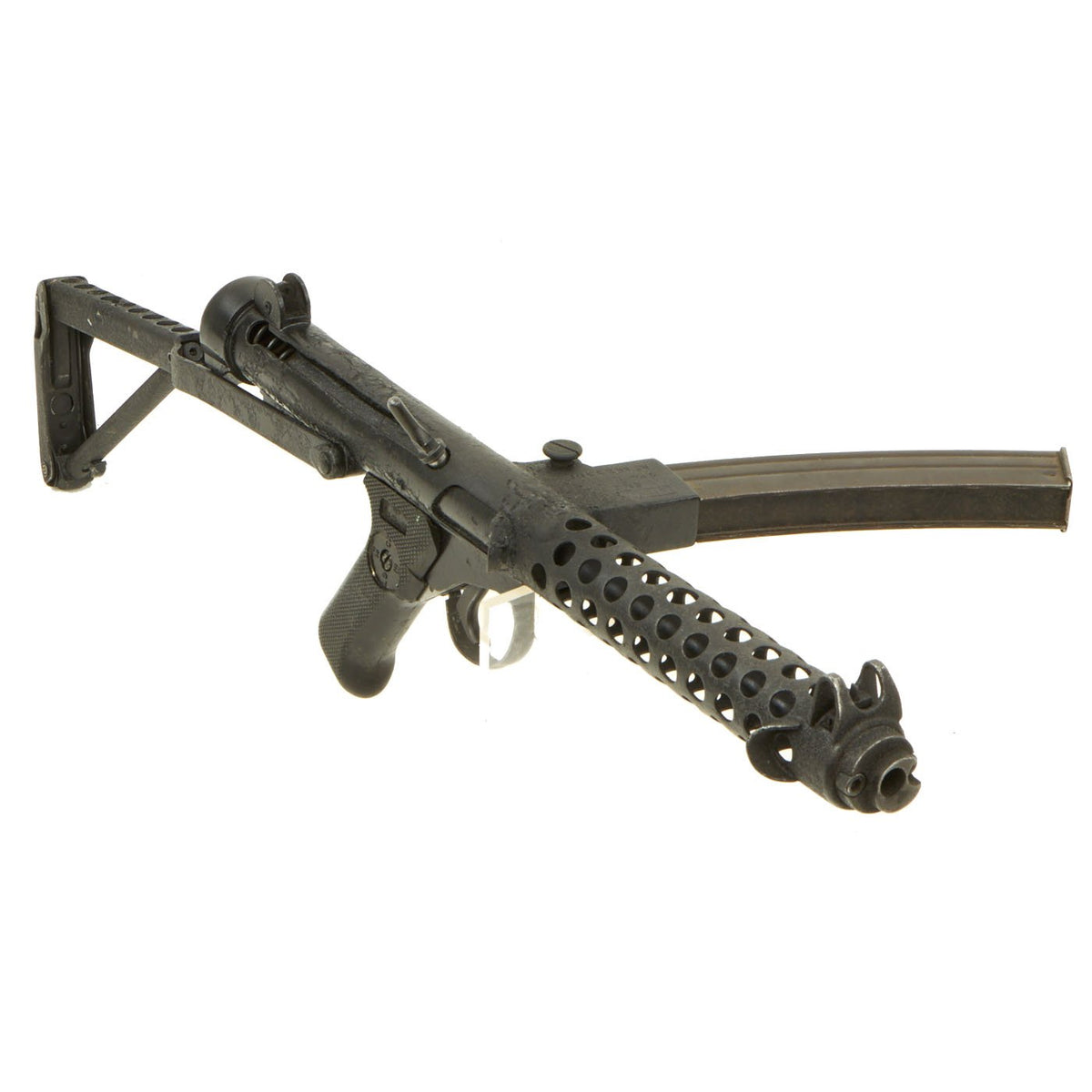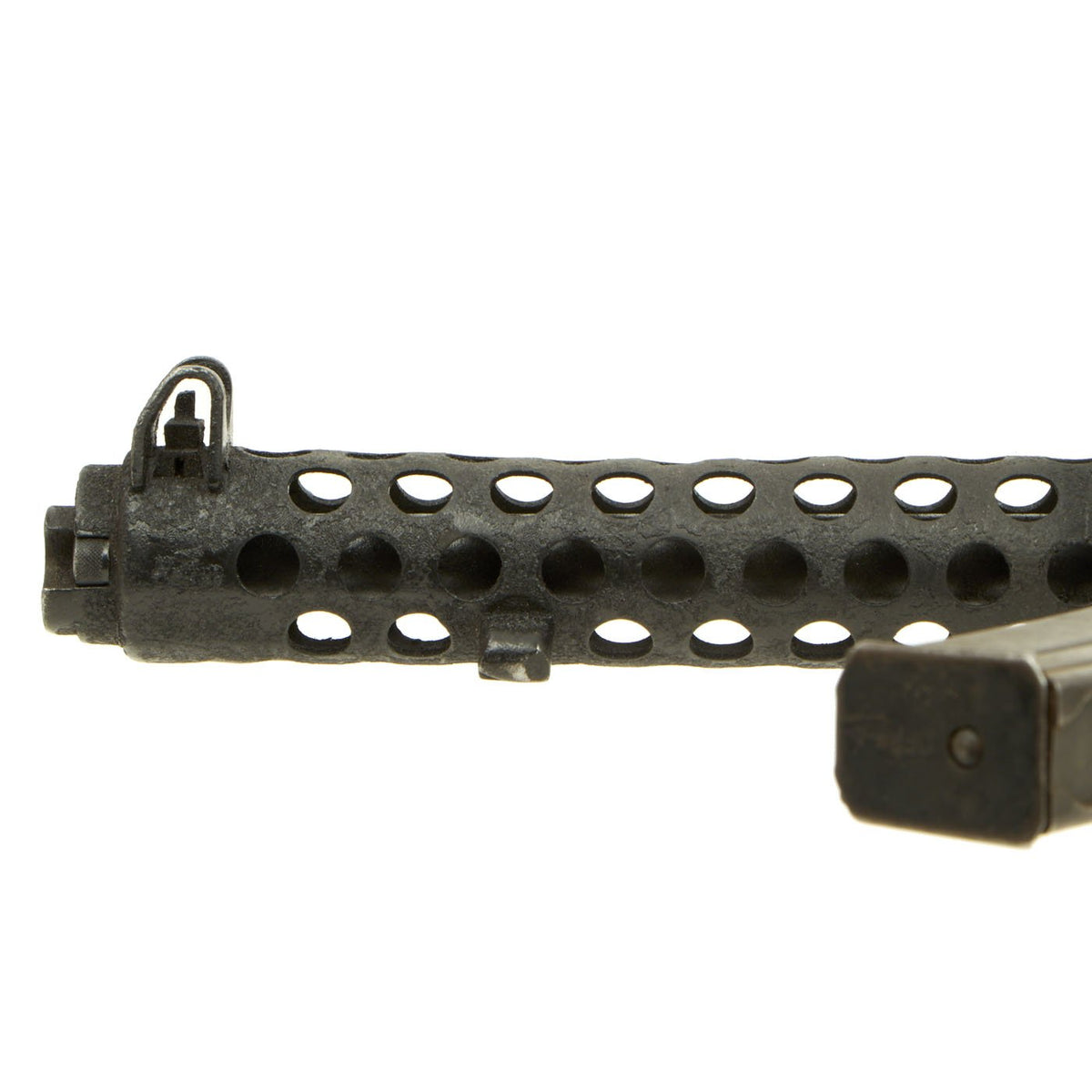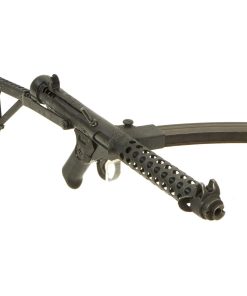Original British Sterling SMG Mk IV L2A3 Display Gun with Magazine – Serial No KR25361 Original Items
$ 1.295,00 $ 323,75
Original Item: Only One Available. This is a very good condition Sterling Mark 4 (L2A3) display gun. You don’t see these often and if you do it has generally been adapted for use in a STAR WARS film. This is the most exciting SMG of post WWII years, the British 9mm Sterling MkIV SMG!
This display gun is superbly built from all original post WWII parts then fitted with a solid steel totally non-operational BATF approved display receiver, making it legal to own in the USA. It still has the complete markings visible on the magazine well:
[STERLING]
SMG
9M/M MK 4 (L2A3)
No KR25361
It has been refinished in a very nice crinkle black paint to resemble the original powder coated finish. It has a fully operational folding stock and moveable trigger, with the selector still movable. It even comes complete with a curved Sterling 9mm Magazine (where permitted). The magazine catch is fully functional, and the folding stock properly stows under the front of the gun.
We have not had one of these for quite some time, and it will not last long!
History of the Sterling submachine gun-
The Sterling submachine gun is a British submachine gun. It was trialled with the British Army in 1944-1945 as replacement for the Sten but it did not start to replace the Sten until 1953. It remained in use until 1994, when it was phased out with the introduction of the L85A1 assault rifle.
n 1944 the British General Staff issued a specification for a new submachine gun. It stated that the weapon should not weigh more than six pounds (2.7 kg), should fire 9×19mm Parabellum calibre ammunition, have a rate of fire of no more than 500 rounds per minute and be sufficiently accurate to allow five single shots to be fired into a one foot square target at 100 yards (91 m).
To meet the new requirement, George William Patchett, the chief designer at the Sterling Armaments Company of Dagenham submitted a sample weapon of new design in early 1944. The army quickly recognised its potential (i.e. significantly increased accuracy and reliability when compared to the Sten) and ordered 120 examples for trials. Towards the end of the Second World War, some of these trial samples were used in combat by airborne troops at Arnhem and elsewhere, where it was known as the Patchett submachine gun. Given that the Patchett/Sterling can use straight Sten submachine gun magazines as well as the curved Sterling design, there were no interoperability problems.
After the war, with large numbers of Sten guns in the inventory there was little interest in replacing them with a superior design. However, in 1947 a competitive trial between the Patchett, an Enfield design, a new BSA design and an experimental Australian design was held, with the Sten for comparison. The trial was inconclusive but was followed by further development and more trials. Eventually the Patchett design won and the decision was made in 1951 for the British Army to adopt it. It started to replace the Sten in 1953 as the Sub-Machine Gun L2A1. Its last non-suppressed variation was the L2A3, but the model changes were minimal throughout its development life.
Sterling submachine guns with minor cosmetic alterations were used in the production of the Star Wars movies as blaster rifle props.
Variants:
British Army
Unassigned: Patchett Machine Carbine Mark 1 (trials commenced in 1944)
Unassigned: Patchett Machine Carbine Mark 1 & Folding Bayonet (same as above but with folding bayonet, never accepted)
L2A1: (Patchett Machine Carbine Mark 2) Adopted in 1953.
L2A2: (Sterling Mark 3) Adopted in 1955.
L2A3: (Sterling Mark 4) Adopted in 1956. Last regular version in service with the British Army.
L34A1: Suppressed version (Sterling-Patchett Mark 5). Held in reserve by the British Army.
Fast Shipping with Professional Packaging
Thanks to our longstanding association with UPS FedEx DHL, and other major international carriers, we are able to provide a range of shipping options. Our warehouse staff is expertly trained and will wrap your products according to our exact and precise specifications. Prior to shipping, your goods will be thoroughly examined and securely secured. We ship to thousands clients each day across multiple countries. This shows how we're dedicated to be the largest retailer on the internet. Warehouses and distribution centres can be located throughout Europe as well as the USA.
Note: Orders with more than one item will be assigned a processing date depending on the item.
Before shipping before shipping, we'll conduct a thorough inspection of the items you have ordered. Today, the majority of orders will be delivered within 48 hours. The delivery time will be between 3-7 days.
Returns
The stock is dynamic and we cannot completely manage it because multiple stakeholders are involved, including our factory and warehouse. So the actual stock may alter at any time. It's possible that you may not receive your order once the order has been made.
Our policy is valid for a period of 30 days. If you don't receive the product within 30 days, we are not able to issue a refund or an exchange.
You can only return an item if it is unused and in the same state as the day you received it. You must have the item in its original packaging.
Related products
Uncategorized
Uncategorized
Armoured Fighting Vehicles of the World: AFVs of World War One (Hardcover Book) New Made Items
Uncategorized
Uncategorized
Uncategorized
Uncategorized
Band of Brothers ORIGINAL GERMAN WWII Le. F.H. 18 10.5cm ARTILLERY PIECE Original Items
Uncategorized
Australian WWII Owen MK1 Machine Carbine SMG Custom Fabricated Replica with Sling Original Items
Uncategorized
Uncategorized
Uncategorized
Uncategorized
Uncategorized
Uncategorized
Uncategorized
Uncategorized
Armored Burgonet Helmet & Polearm from Scottish Castle Leith Hall Circa 1700 Original Items
Uncategorized
Uncategorized












































































